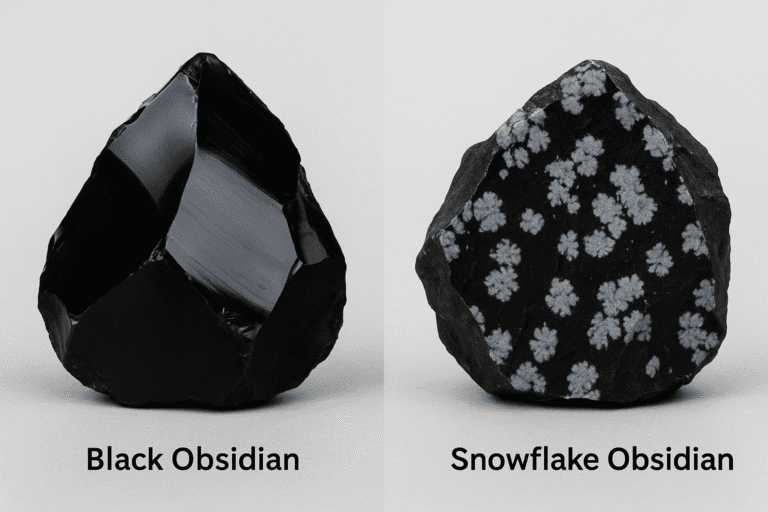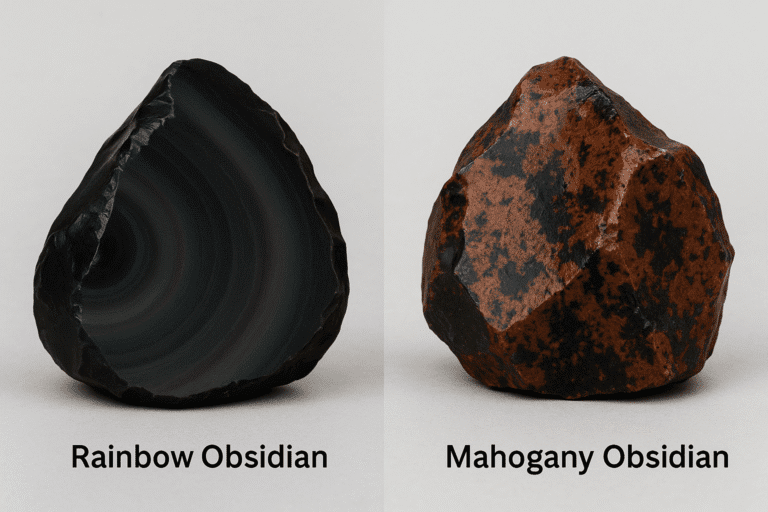Monthly Mineral Spotlight – September
Obsidian: Volcanic Glass With a Human Story
Obsidian is one of the most dramatic materials a rockhound can discover. With its glassy texture, razor-sharp edges, and deep volcanic origins, obsidian has fascinated people for thousands of years. This guide explores obsidian’s formation, varieties, Indigenous uses, and field identification.
What Is Obsidian?
Obsidian is a natural volcanic glass formed when high-silica lava cools too quickly to crystallize. It does not have a mineral structure — instead, it behaves like a frozen liquid.
SEO keywords: obsidian identification, obsidian varieties, volcanic glass, natural obsidian.
Quick Identification Guide
• Glassy, reflective luster
• Conchoidal fracture (shell-like breakage)
• Typically black
• Translucent edges when held to light
• Hardness ~5.5
• Very sharp edges (handle with care)
How Obsidian Forms
Obsidian forms in high-silica volcanic environments:
• Rhyolitic lava flows
• Volcanic domes
• Flow margins
• Rapid-cooling lava
• Silicic ash-flow tuffs
Its formation is tied to some of the most explosive volcanic eruptions on Earth.
Varieties of Obsidian
Snowflake Obsidian
Contains gray-white cristobalite inclusions.
Mahogany Obsidian
Red-brown streaks through black glass.
Rainbow Obsidian
Internal fiber structures create iridescent color.
Sheen Obsidian
Gold or silver metallic sheen.
Midnight Lace Obsidian
Striped, translucent banding.
Obsidian and Indigenous History
Obsidian was a crucial toolmaking material across North and South America. Cultures shaped it into:
• arrowheads
• spear points
• knives
• scrapers
• ceremonial blades
Obsidian trade networks extended hundreds of miles; geochemical “fingerprinting” can still trace the origin of artifacts to specific volcanoes.
Where Obsidian Is Found
United States
• Oregon — Glass Butte, Newberry Volcano
• Northern California — Medicine Lake Highlands
• Northern Nevada — Black Rock Desert, Double H Mountains
• Arizona and New Mexico — Southwestern volcanic fields
Worldwide
• Mexico
• Japan
• Italy
• Iceland
• Turkey
• The Andes
Rockhounding Safety Tips
• Wear gloves — edges are extremely sharp
• Don’t hammer obsidian; it can shatter violently
• Carry specimens safely wrapped
• Avoid collecting in restricted volcanic areas
Lapidary Uses
Obsidian polishes to a beautiful, mirror-like shine and is used for:
• Cabochons
• Carvings
• Display spheres
• Arrowhead replicas
• Artistic blades
FAQs About Obsidian
Is obsidian a mineral?
No — it is a mineraloid (volcanic glass) with no crystal structure.
Can obsidian be different colors?
Yes. Sheen, rainbow, and mahogany varieties are common.
Why is obsidian so sharp?
Because glass fractures conchoidally and forms extremely thin edges.
Conclusion
Obsidian captures the drama of volcanic geology and the ingenuity of early human toolmaking. Its glassy beauty and rich history make it an ideal mineral to spotlight for September.

